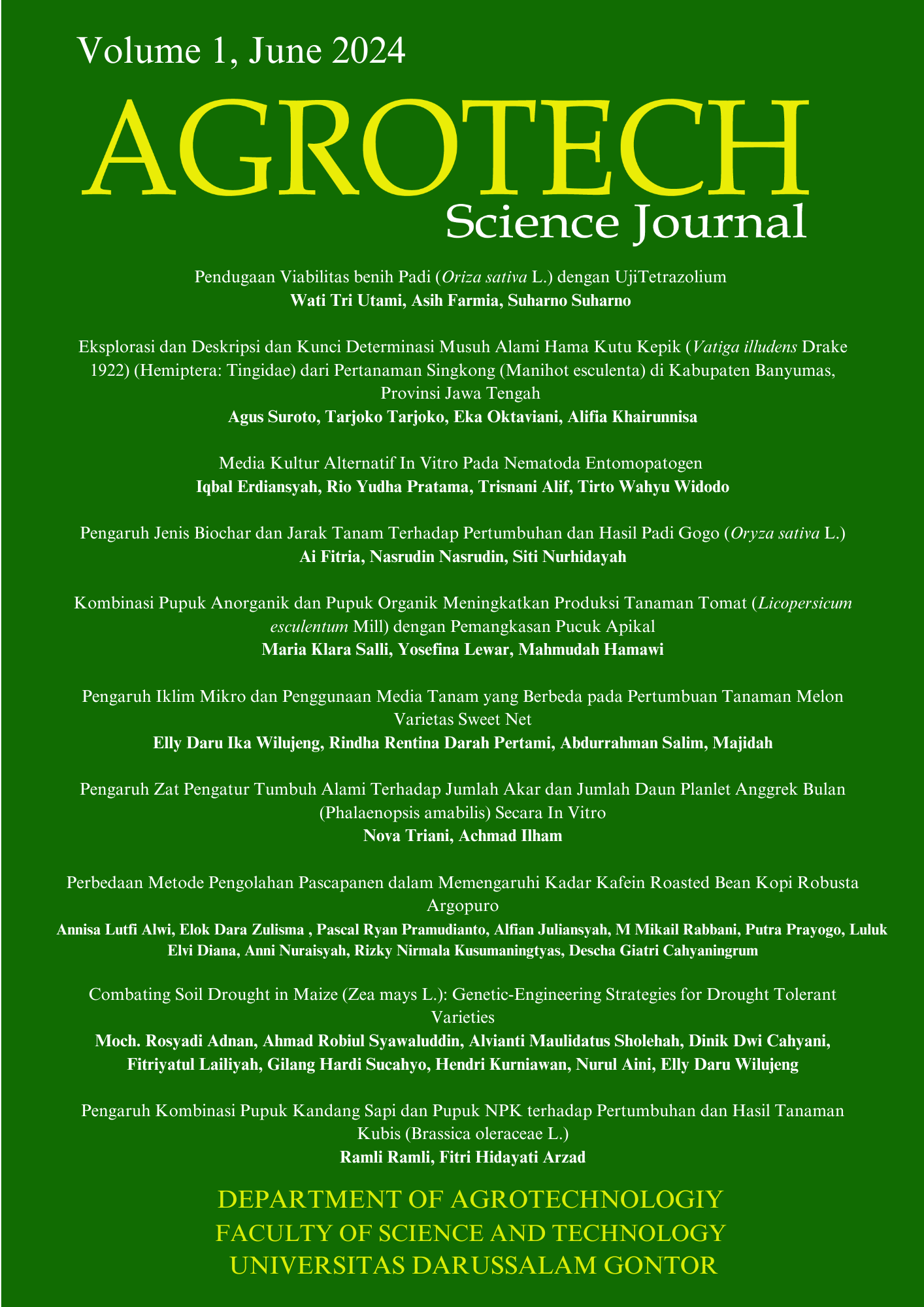Perbedaan Metode Pengolahan Pascapanen dalam Memengaruhi Kadar Kafein Roasted Bean Kopi Robusta Argopuro
The Differences in Post-Harvest Processing Methods In Affecting Caffeine Content Of Argopuro Roasted Coffee Beans
DOI:
https://doi.org/10.21111/agrotech.v10i1.12234Abstract
This study aims to determine the caffeine content of Argopuro Jember robusta coffee beans based on differences in post-harvest processing methods. The research was conducted at the Jember State Polytechnic Agricultural Products Processing (PHP) Laboratory and the Jember State University Integrated Testing Unit Laboratory in June-September 2022. The samples were robusta coffee logs originating from the Argopuro area of ​​Jember. The post-harvest coffee processing process is divided into four (4) methods, namely natural processing (dry process), semi-wet processing, wet (full wash process), and honey processing. Green beans from the results of each processing method are roasted at light, medium, and dark levels. The roasted bean caffeine content test from each post-harvest processing method at each roasting level was carried out descriptively (simple, without repetition). Overall, the caffeine content of the roasted beans produced in this study still meets the SNI 01-3542-2004 standard, a maximum of 2%. The caffeine content of Argopuro Jember robusta coffee roast beans at the light roast level ranges from 1.44-1.65%, 1.38-1.92% for medium roast, and 1.61-1.81% for dark roast. The highest caffeine content in roasted beans at each roasting level is 1.65% (dry process), 1.92% (full wash process), and 1.81% (full wash process), respectively. Meanwhile, roasted beans with the lowest caffeine content with a value of 1.38% are produced using the semi-wet process processing method at a medium roast level. The fluctuations in caffeine values ​​produced in this study indicate that post-harvest processing methods do not affect the caffeine content of roasted beans at light, medium, or dark roast levels.References
Belay, A., Ture, K., Redi, M., & Asfaw, A. (2008). Measurement of caffeine in coffee beans with UV/vis spectrometer. Food Chemistry, 108(1), 310-315.
Belguidoum, K., Amira-Guebailia, H., Boulmokh, Y., & Houache, O. (2014). HPLC coupled to UV–vis detection for quantitative determination of phenolic compounds and caffeine in different brands of coffee in the Algerian market. Journal of the Taiwan Institute of Chemical Engineers, 45(4), 1314-1320.
Bermeo, A. H., Bahamon, M. A. F., Aragon, C. R., Beltran, V. Y., Gutierrez, G. N. 2022. Is Coffee (Coffea arabica L.) Quality-Related to a Combined Farmer-Farm Profile? Sustainability (12), 9518.BPS. (2022). Statistik Kopi Indonesia 2021. Jakarta: Badan Pusat Statistik.
Chu, Y. F., Chen, Y., Brown, P. H., Lyle, B. J., Black, R. M., Cheng, I. H. & Prior, R. L. (2012). Bioactivities of crude caffeine: Antioxidant activity, cyclooxygenase-2 inhibition, and enhanced glucose uptake. Food Chemistry, 131(2), 564-568.
Direktorat Jenderal Perkebunan. (2023). Statistik Perkebunan 2021-2023. Jakarta. Direktorat Jenderal Perkebunan.
Farida, A., Ristanti, E., & Kumoro, A. C. (2013). Penurunan kadar kafein dan asam total pada biji kopi robusta menggunakan teknologi fermentasi anaerob fakultatif dengan mikroba nopkor MZ-15. Jurnal Teknologi Kimia dan Industri, 2(3), 70-75.
Janzen SO. (2013). Chemistry of coffee. Hamburg: Elsevier. Pp. 1085-1113.
Leloup, V., Gancel, C., Liardon, R., Rytz, A., and Pithon, A. (2005). Impact Of Wet And Dry Process On Green Coffee Composition And Sensory Characteristics. Bangalore, India, pp. 93–101.
Mir’atannisa, I. M., N. Rusmana, dan N. Budiman. (2019). Kemampuan Adaptasi Positif Melalui Resiliensi. Journal of Innovative Counseling: Theory, Practice & Research, 3(32), 70-75.
Ramanda, M. R., A. F. Prameswari, dan M. N.
Ulfa. (2024). Effect of Variations of Robusta Temperature on the Physicochemical Properties of Robusta Coffee (Coffea canephora L.). Jurnal Teknik Pertanian Lampung, 13(2), 405-417.
Sabarni dan Nurhayati. 2018. Analisis kadar kafein dalam minuman kopi khop Aceh dengan metode spektroskopik. Lantanida Journal, 6(2), 103-202.
Severini, C., Derossi, A., Ricci, I., Fiore, A. G. & Caporizzi, R. (2017). How much caffeine in coffee cup? Effects of processing operations, extraction methods and variables. Dalam Latosinska, J. N. & Latosinska, M. (Editor), The Question of Caffeine (hal. 45-85). Croatia: National and University Library in Zagreb, IntechOpen.
Shrestha, S., Rijal, S. K., Pokhrel, and Rai, K. P. 2016. A simple HPLC method for determination of caffeine content in tea and coffee. Journal of Food Science and Technology, (9), 74-78.
Supriana, N., Ahmad, U., Samsudin, dan Purwanto, E. H. 2020. Pengaruh metode pengolahan dan suhu penyangraian terhadap karakteristik fisiko-kimia kopi robusta. Jurnal Tanaman Industri dan Penyegar, 7 (2), 61-72.
Tello, J., Viguera, M., and Calvo, L. 2011. Extraction of caffeine from Robusta coffee (Coffea canephora var. Robusta) husks using supercritical carbon dioxide. The Journal of Supercritical Fluids, 59, 53-60.
Widyotomo, S., Sri-Mulato; H.K. Purwadaria & A. M. Syarief. (2010). Karakterisasi fisik kopi pascapengukusan dalam reaktor kolom tunggal. Pelita Perkebunan, 26, 25–41.
Wulandari, S., M. Ainuri, dan A. C. Sukartiko. (2021). Biochemical content of Robusta coffees under fully-wash, honey, and natural processing methods. 2nd International Conference Earth Science And Energy. IOP Publishing
Downloads
Submitted
Accepted
Published
How to Cite
Issue
Section
License
The author whose published manuscript approved the following provisions:
1. The right of publication of all material published in the journal / published in the Gontor AGROTECH Science Journal is held by the editorial board with the knowledge of the author (moral rights remain the author of the script).
2. The formal legal provisions for access to digital articles of this electronic journal are subject to the terms of the Attribution 4.0 International, which means that Gontor AGROTECH Science Journal reserves the right to save, transmit media or format, Database), maintain, and publish articles without requesting permission from the Author as long as it keeps the Author's name as the owner of Copyright.
3. Printed and electronic published manuscripts are open access for educational, research and library purposes. In addition to these objectives, the editorial board shall not be liable for violations of copyright law.



